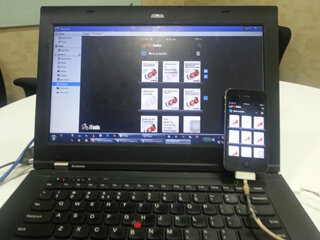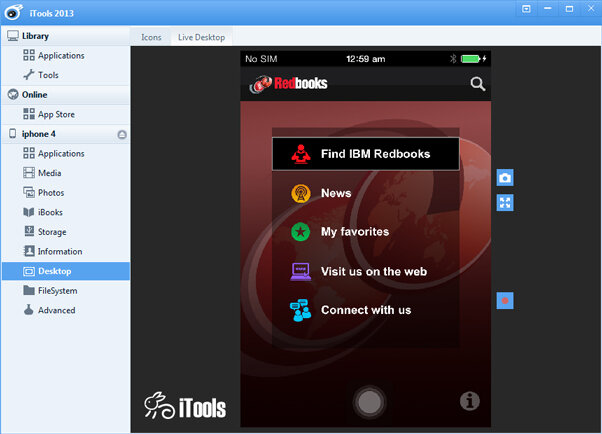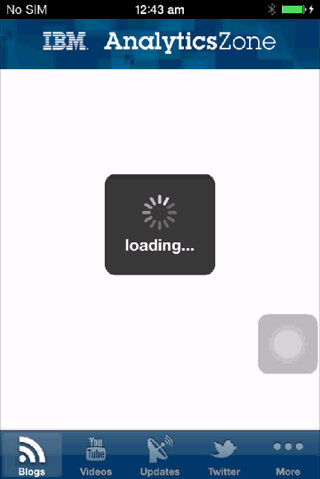making_art
Member
[h=4] Mirroring an iPhone device screen onto your desktop
[/h] Feb 3, 2014
 This blog post is contributed by Murali Krishna who works with the S&D department. He is a BTech graduate by qualification and started his career with Java J2EE development.
This blog post is contributed by Murali Krishna who works with the S&D department. He is a BTech graduate by qualification and started his career with Java J2EE development.
The back story
I am an application developer for IBM, and I was recently working on a native application in iOS for one of our clients in which the camera takes a picture of an object and sends it to the server. Then the server performs a comparison with the predefined list of images already placed on the server and returns the matching percentage back to the device. I was managing the comparison with my Java logic when I realized the real challenge.
When the project is in development, I am supposed to give a demo every week, each time a new person is added to the client's user group to have a look at the project (to suggest any changes required in the flow of the application and in the image recognition process). I cannot do this with the simulator because the camera does not work in it. At the same time, I cannot travel to the client's location every day. So the best option that I was left with is projecting the screen of the mobile device onto the desktop and sharing the desktop with the onsite people.
So I did a little research on how to share my mobile device screen on a desktop. After a few days of investigation, I learned quite a bit and thought I would share this knowledge.

Mirroring your screen in the iPhone platform
Here are three options that I discovered for iOS:
iTools
A great way of seeing and controlling your device remotely from your desktop is to use the software called iTools, which is available for both Windows and Mac platforms. You also do not need to have an Internet connection to do this. The process is pretty straightforward (same for both Windows and Mac). The only constraint here is that you should have iTunes installed on your desktop. Here are the steps:



And please watch for my next posts to learn what solutions for screen mirroring are available for Android and BlackBerry.
[/h] Feb 3, 2014
inShare9
 This blog post is contributed by Murali Krishna who works with the S&D department. He is a BTech graduate by qualification and started his career with Java J2EE development.
This blog post is contributed by Murali Krishna who works with the S&D department. He is a BTech graduate by qualification and started his career with Java J2EE development.The back story
I am an application developer for IBM, and I was recently working on a native application in iOS for one of our clients in which the camera takes a picture of an object and sends it to the server. Then the server performs a comparison with the predefined list of images already placed on the server and returns the matching percentage back to the device. I was managing the comparison with my Java logic when I realized the real challenge.
When the project is in development, I am supposed to give a demo every week, each time a new person is added to the client's user group to have a look at the project (to suggest any changes required in the flow of the application and in the image recognition process). I cannot do this with the simulator because the camera does not work in it. At the same time, I cannot travel to the client's location every day. So the best option that I was left with is projecting the screen of the mobile device onto the desktop and sharing the desktop with the onsite people.
So I did a little research on how to share my mobile device screen on a desktop. After a few days of investigation, I learned quite a bit and thought I would share this knowledge.

Figure 1: Mirroring a device onto the desktop
I figured out several different solutions for iOS, and in future posts I'll explain how to mirror your screen on the Android and BlackBerry platforms.Mirroring your screen in the iPhone platform
Here are three options that I discovered for iOS:
- Buying mobile apps from the Apple App Store, which helps you in this process, or buying an application like Reflector
- Using the AirPlay feature, which works over WiFi and requires all devices using it to be on the same network
- Using iTools (no need to buy any software), which I outline in more detail below
iTools
A great way of seeing and controlling your device remotely from your desktop is to use the software called iTools, which is available for both Windows and Mac platforms. You also do not need to have an Internet connection to do this. The process is pretty straightforward (same for both Windows and Mac). The only constraint here is that you should have iTunes installed on your desktop. Here are the steps:
- Download and install iTools.
- Connect the iPhone to the desktop using a USB cable.
- Open iTools, select the device from the left panel and go to the "Live Desktop" option.

Figure 2: This is how the device's screen looks on the desktop.

Figure 3: A screen capture taken while demonstrating one of our tools to the remote team.

Figure 4: A screen capture taken while demonstrating one of our tools to the remote team.
My research paid off, and I was able to use some of these tools to share my mobile screen with my client to demonstrate our progress in the project. I hope that by sharing what I learned you will now understand how to mirror your iPhone screen onto your desktop with ease. Leave a comment or send me a question on Twitter @MuralikrishnaMI to talk more about enterprise mobility.And please watch for my next posts to learn what solutions for screen mirroring are available for Android and BlackBerry.
